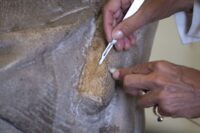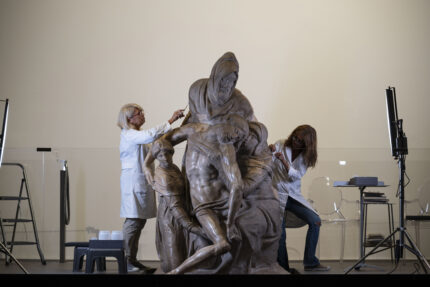Conservation of the Bandini Pietà, one of Michelangelo’s last sculptures and one of his most striking (in more ways than one), has revealed previously unknown details from its violent creation. Under centuries of grime, restorers found everything from the artist’s original chisel marks to colors left behind in past work on the white marble.
The Opera di Santa Maria del Fiore, the organization which manages the works in the collection of the Duomo Museum, began a comprehensive cleaning and conservation program last November. This is the first true restoration of the sculptural group in its nearly 500-year history. Work, rudely interrupted by you-know-what, has resumed. The thorough cleaning of the surface has been completed on the back of the sculpture and is in its initial phases on the front.
Ongoing diagnostic surveys have provided information considered to be fundamental for the knowledge of the work and its restoration: there is no historic patina with the exception of traces found at the base of the sculpture, something that is still being investigated. The presence of elevated quantities of chalk from the cast executed in the 1800s has instead been confirmed. These results have led to cleaning operations first and then to start the intervention at the back. The waxes present on the surface, including those from candles that were used on the main altar of Florence’s cathedral where the sculpture was kept for over 220 years, were removed with a scalpel.
According to his Giorgio Vasari, Michelangelo began the sculpture on his own with no commission. It was 1547. He was in his early 70s and painting frescoes had become too strenuous for him. Chiseling four figures out of a hunk of Carrara marble eight feet high, on the other hand, was just a good way to pass the time and stay fit. Unlike his first and most famous Pietà now in St. Peter’s Basilica which features a youthful Virgin Mary with the body of Christ draped across her ample lap, the dominant figure is that of Nicodemus who stands behind the limp, twisted body of Jesus, helping Mary the Mother (right) and Mary Magdalene (left) support the dead Christ. Michelangelo intended it for his own tomb, and purportedly the face of Nicodemus is a self-portrait.
Papal and Medici projects for churches, palaces and bridges constantly interrupted his work on the sculpture and the piece itself became an exercise in frustration as he encountered constant flaws in the hard marble that made it impossible to complete as he’d envisioned. Vasari said it was so “full of emery” that the chisel set off sparks. He also said that Michelangelo had by this point in his life become such a terminal perfectionist that he never completed any sculpture to his satisfaction, that all his finished works were done in his youth, and even then if it had been up to him he never would have turned them over to his patrons.
Finally one evening in 1555, Michelangelo’s frustration boiled over. One of the Madonna’s elbows had broken when he was working on it. Michelangelo then deliberately broke of other body parts from the statue. His servant Antonio stopped him from completely smashing it to pieces and asked the master to give it to him as is. Antonio sold all the pieces of the broken group to the Florentine banker Francesco Bandini who enlisted Tiberio Calcagni, a sculptor and a collaborator of Michelangelo’s, to put the Pietà back together again as much as possible and fill in any blanks he could.
 Calcagni’s work from around 1565 was the last clearly identifiable intervention on sculpture until the Opera di Santa Maria del Fiore’s project. The conservation was performed in public view at the museum before the pandemic shut them down. Starting September 21st, guided tours of no more than five visitors will be allowed to view the work in progress.
Calcagni’s work from around 1565 was the last clearly identifiable intervention on sculpture until the Opera di Santa Maria del Fiore’s project. The conservation was performed in public view at the museum before the pandemic shut them down. Starting September 21st, guided tours of no more than five visitors will be allowed to view the work in progress.

This is the Earth.
How much of a perfectionist’s suffering is the direct result of pride, I am not sure…certainly at least a fraction, if not the whole.
Some of us are neurotically avoidant of finishing anything, lest we have to deliver imperfection.
Some artists’ sufferings increase over time, as previous successes demand more and increasingly-creative accomplishments from ones with decreasing abilities.
Some succeed in detaching from the demand, and go on to develop new ways of creating. Others don’t, and some don’t end well.